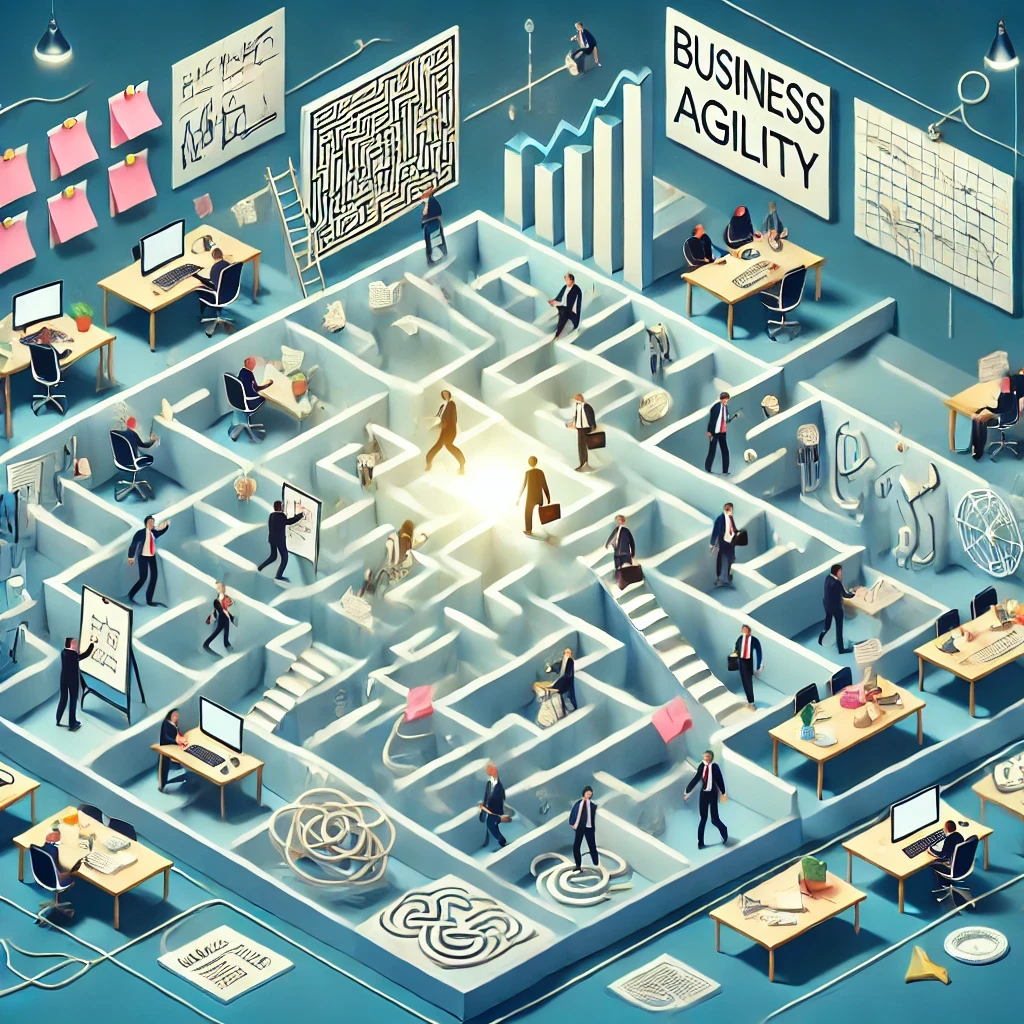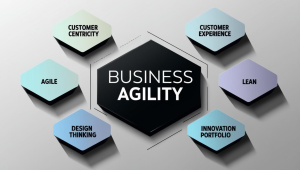
Why on earth does it seem more and more difficult to work well in a company?
Spoiler: it’s not you. It’s the complexity.
But there is also a way out: Business Agility.
In this post I share with you practical (and smoke-free) ideas on how business agility helps you navigate an environment of contradictions, without dying trying.
Welcome to the age of complexity (and contradiction).
Imagine you are asked to launch a product that is cheap and of high quality. It must arrive quickly, be reliable, adapt to each customer and be globally standardized. Oh, and that it is also innovative and efficient.
Yes, it sounds like a joke… but it is the everyday life of many organizations.
As Yves Morieux explains:
“Business complexity arises from having to satisfy multiple, often conflicting, performance requirements at the same time.”
And it’s true. We want low cost and quality, speed and reliability, standardization and customization, innovation and efficiency, global consistency and local adaptation.

Contradiction in action: the hidden cost of the impossible
Reliability requires controls, which slow down the speed.
Innovation needs to try for the first time.
Efficiency is based on repeating many times.
And as the environment becomes more demanding, the organizational complexity grows unchecked:
more layers, processes, metrics, systems, reports, meetings…
In our organizational transformations, we see it all the time: companies are trying to respond to complexity… by adding more internal complexity.
The result?
Stressed people, without focus, trapped in meetings and scorecards. Sense is lost. Courage is lost.
It’s not just a matter of large corporations
This is not a Silicon Valley oddity.
It’s the new global standard. Companies in every industry are competing to satisfy customers, employees, investors, regulators… and even LinkedIn’s algorithm.
And they do so while their internal system becomes increasingly rigid, slower and more difficult to understand.
In our organizational consulting, we work with organizations that are saturated with overlapping structures and endless decision chains. Teams do not fail because of a lack of talent, but because the system holds them back.
The big mistake: responding to complexity… with more complexity
The complexity of the environment can be a source of innovation.
The problem arises when the organizational response to this complexity is to create more processes, more controls, more bureaucracy. We know how this ends up.
In fact, it is estimated that in most organizations, managers spend 40% of their time writing reports and 30% in meetings. So, at most, they have 30% left to spend with their teams. Therefore, the teams are mismanaged. They are working in the wrong direction, without the right guidance.
This organizational labyrinth is disorienting. People lose focus, motivation and meaning. And the worst thing: they get used to working a lot… without generating value.

Complexity as a competitive advantage
It’s not all drama.
Whenever a company resolves contradictions intelligently, it gains an advantage:
H&M combines fashion and affordability.
Netflix offers personalized abundance.
Southwest Airlines operates quickly and reliably.
Amazon has made its logistics part of the brand value.
These organizations don’t win because they work harder. They win because they organize better.
They have redesigned their operating models to better adapt.
That’s Business Agility in action.
This is where Business Agility and Complexity come in.
Business Agility is neither a methodology nor a framework.
It is an organizational skill: the ability to change, learn and pivot business strategy to adapt quickly and thrive.
Business Agility is the organizational ability to be able to change, learn and pivot business strategy to adapt quickly and thrive.
And you don’t buy it on Amazon or download it in a plugin. You build it. It is trained. You live it.
“Business agility is what allows you to transform change into competitive advantage.” From our Agile consultancy, we help organizations to develop this capability as a sustainable competitive advantage.
The 6 legs of Business Agility
As a point of synchronization, when we talk about Business Agility and complexity, let’s remember the 6 areas of Enterprise Agility
- Customer Centricity: Design with the customer at the center. It means making decisions from the end user’s point of view, not from internal silos. It involves listening, empathizing, observing and above all, prioritizing what brings real value to the customer over what “suits” the internal structure.
- Customer Experience: Living the customer experience and constantly improving it. It is much more than satisfaction surveys. It is mapping the entire user journey, identifying friction points, and designing memorable experiences that build loyalty. A great experience is often more powerful than the best marketing.
- Agile: Adaptability, iteration and collaboration mentality. It is not about applying Scrum or Kanban and that’s it. It’s about adopting a culture where teams deliver value in short cycles, learn from feedback and adapt quickly. Where collaboration is prioritized over hierarchy and realistic planning over the illusion of control.
- Lean: Doing more with less, eliminating waste. Lean reminds us that work is not only about doing, but also about stopping doing what does not add value. Identifying bottlenecks, useless bureaucracy, duplication and unnecessary processes can free up a lot of energy and talent that is currently trapped in inertia.
- Design Thinking: Solving problems by putting people at the center. It is a methodology (and a mindset) to address complex problems from empathy, creativity and experimentation. It allows us to move from “this has always been done this way” to “let’s try a new way” in a structured way, validating with real users.
- Innovation Portfolio: Managing innovation as a living and balanced system. Innovation is not about doing hackathons or having a team hidden in a room of post-its. It is managing a portfolio of initiatives with different levels of risk and impact, from incremental improvements to disruptive bets. As in a good investment, you have to diversify and learn from each experiment.

These dimensions function as a GPS for any modern organization that wants to reduce organizational complexity and better respond to the environment.
Reducing organizational complexity: 6 game changing rules
Inspired by the work of Yves Morieux, here are six principles for surviving and standing out:
Understand what your people really do
Less organizational charts, more direct observation. Identify real value streams.Reinforce integrators
It’s not a position, it’s a role. They are the ones who connect silos and resolve tensions. They are key to driving cultural change.Increase the power available
Don’t centralize everything. Empower decisions close to the customer. With context, not just authority.Encourages reciprocity
Less assigned tasks, more shared agreements. “I help you, you help me” as the operational basis.Widen the shadow of the future
Quick feedback, clear consequences. No more empty KPIs: more real accountability.Reward cooperation, hold disconnection accountable
Culture is not what you say, it’s what you tolerate and acknowledge.

These rules create an environment where autonomy flourishes without becoming chaos, and where collaboration ceases to be a pretty sign and becomes standard practice.
Real examples of Business Agility vs. complexity
Michelin: betting on tires that last longer. Less sales today, leadership tomorrow.
Spotify: mass customization that standardizes.
Amazon: return is part of the value, not a hassle.
All these cases show how well-designed simplicity is the best response to external complexity.
But why don’t all companies do it?
The theory is clear. So are the benefits. So…
“If Enterprise Agility is so advantageous…. why the hell doesn’t everyone adopt it?”
Two very human reasons:
- Because it requires time and a change of mentality.
- Because the urgent kills the important.
There is a mythical image: two cavemen dragging a cart with square wheels. Someone offers them round wheels and they reply: “we don’t have time”.
Sad, but real.
Organizational Agility and complexity is not a destination. It is a path.
There is no “final level of agility”. It is a continuous practice of:
- Listen better.
- Experiment more.
- Fast learner.
- Adapt as necessary.
It is to change “control and efficiency” for “trust and continuous evolution”.
And that, my friend reader, hurts. But it also liberates.
In a nutshell

✔️ The world is becoming increasingly complex.
✔️ The answer is not more bureaucracy, but better adaptability.
✔️ Business Agility turns that complexity into an advantage.
✔️ It is not imposed: it is practiced, built and trained.
Do you want to start that path? From SmartWay we help you with:
Complexity is not going to go away. But you can change how you manage it.
How many processes in your company exist just to survive complexity… instead of solving it?


